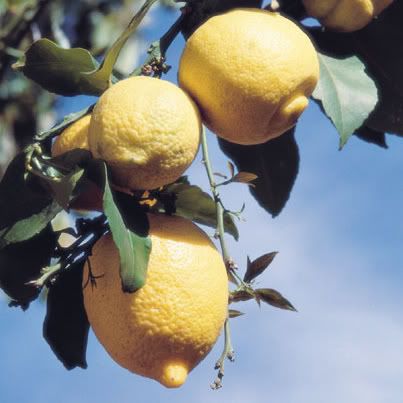 Lemon (from Wikipedia)
Lemon (from Wikipedia)"The first real lemon cultivation in Europe began in Genoa in the middle of the fifteenth century. It was later introduced to the Americas in 1493 when Christopher Columbus brought lemon seeds to Hispaniola along his voyages."
The lemon is a small evergreen tree (Citrus limon) originally native to Asia, and is also the name of the tree's oval yellow fruit. The fruit is used for culinary and nonculinary purposes throughout the world – primarily for its juice, though the pulp and rind (zest) are also used, mainly in cooking and baking. Lemon juice is about 5% (approximately 0.3 mole per liter) citric acid, which gives lemons a tart taste, and a pH of 2 to 3. This makes lemon juice an inexpensive, readily available acid for use in educational science experiments. Because of the tart flavor, many lemon-flavored drinks and candies are available on the market, including lemonade.
History
The exact origin of the lemon has remained a mystery, though it is widely presumed that lemons first grew in India, northern Burma, and China. In South and South East Asia, it was known for its antiseptic properties and it was used as an antidote for various poisons. It was later introduced to Persia and then to Iraq and Egypt around AD 700. The lemon was first recorded in literature in a tenth century Arabic treatise on farming, and was also used as an ornamental plant in early Islamic gardens. It was distributed widely throughout the Arab world and the Mediterranean region between AD 1000 and AD 1150.
 Lemons entered Europe (near southern Italy) no later than the first century AD, during the time of Ancient Rome. However, they were not widely cultivated. The first real lemon cultivation in Europe began in Genoa in the middle of the fifteenth century. It was later introduced to the Americas in 1493 when Christopher Columbus brought lemon seeds to Hispaniola along his voyages. Spanish conquest throughout the New World helped spread lemon seeds. It was mainly used as ornament and medicine. In 1700s and late 1800s, lemons were increasingly planted in Florida and California when lemons began to be used in cooking and flavoring.
Lemons entered Europe (near southern Italy) no later than the first century AD, during the time of Ancient Rome. However, they were not widely cultivated. The first real lemon cultivation in Europe began in Genoa in the middle of the fifteenth century. It was later introduced to the Americas in 1493 when Christopher Columbus brought lemon seeds to Hispaniola along his voyages. Spanish conquest throughout the New World helped spread lemon seeds. It was mainly used as ornament and medicine. In 1700s and late 1800s, lemons were increasingly planted in Florida and California when lemons began to be used in cooking and flavoring.In 1747, James Lind's experiments on seamen suffering from scurvy involved adding Vitamin C to their diets through lemon juice. The name lemon was originated from Arabic līmūn and Persian limun through Old Italian and Old French limone.

No comments:
Post a Comment